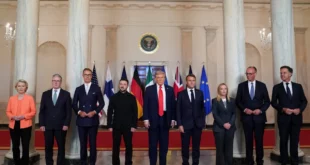Since its 2019 defeat, ISIL has morphed into a series of affiliates taking hold in Afghanistan and Africa’s Sahel belt.
The Islamic State of Iraq and the Levant (ISIL, or ISIS) has changed form several times over the years.
With its origins in the aftermath of the US invasion of Iraq in 2003, ISIL was forged from an alliance between an al-Qaeda offshoot and elements of the defeated Iraqi Baath party. The group grew exponentially, basing itself in the disaffected Sunni areas of central Iraq, with the aim of setting up an Islamic caliphate.
Increasingly open in its religious proclamations, ISIL’s slick propaganda (PDF) upstaged al-Qaeda’s older grainy videos, winning converts with its high-tech, well-edited advertisements showing training and the bloody aftermath of attacks carried out by the group.
The group grew and grew, telling the world about their “victories” in high-definition videos that served as recruitment tools, spread far and wide through social media. By 2015, they controlled an area of Iraq and Syria the size of the United Kingdom. Taxes were now raised, civil service was set up, and the caliphate had its own government and economy; all the trappings of a state. It took the combined might of several military powers to finally defeat ISIL, with the last ISIL strongpoint in Baghouz in eastern Syria falling in March 2019.
Down but not out by a long shot, ISIL has still been able to launch an increasing number of attacks in Iraq and northern Syria over the last six months. These culminated in an assault on a prison in January by hundreds of fighters in a brazen attempt to free ISIL captives being held there. The ensuing battle between ISIL and Kurdish-dominated Syrian Democratic Forces (SDF) fighters lasted seven days. Despite these well-planned attacks, ISIL does not control the territory like it used to and has had to adjust its strategy accordingly.
Becoming decentralised
The draw of a centralised caliphate is no longer there. ISIL’s successes are minor and distributed in hotspots around the world. No longer do young fighters stream in from the West; recruitment is more gradual and usually from the local population. Turkey, once the transit point for incoming fighters heading to Iraq and Syria, is much more vigilant and the domestic intelligence agencies have been far better at identifying potential ISIL recruits and stopping them from travelling abroad. Those that have returned and are allowed back are monitored.
Communications have also been curbed. Gone are the slick videos and web magazines as site after site is targeted by intelligence agencies and shut down.
Encrypted communications apps like Telegram are now used more frequently where successes are displayed and communications between potential volunteers and recruiters go relatively undetected.
US military activity has been dialled down and ISIL recruiters no longer have the draw of an international struggle as a propaganda recruitment tool. Nor does it have the string of brutal victories common in 2014 as the group took swaths of central Iraq and eastern Syria.
However, bloody attacks are still carried out and claimed as propaganda successes, like that by ISIL’s Afghanistan affiliate on Kabul airport on August 26, 2021, which killed at least 175 people.
Existential battle with the Taliban
ISIL’s global propaganda drive has been weakened in some ways by the establishment of what the Taliban has declared to be the Islamic Emirate of Afghanistan.
The Afghan affiliate, the Islamic State in Khorasan Province, ISKP (ISIS-K), has had a history of high-profile, high casualty attacks in the country. Clashes between the two groups accelerated as the Taliban steadily took control of the country, culminating in a lightning offensive in 2021 when the Taliban took the remainder of the country in just a few weeks. With the Taliban now in government and promoting peace, ISIL recruiters had to resort to paying recruits to carry out attacks. Most of these were aimed at Shia and Hazara mosques in an effort to exploit religious divides in the country.
Having now transitioned from fighters to civil servants, the Taliban is in the ironic position of having to conduct campaigns against a network of ISIL fighters who are well versed in hiding themselves in cities. ISIL in Afghanistan also leverages the Taliban’s uncomfortable transition with disaffected members of the Taliban who are easier to recruit.
The two groups are now locked in an existential battle for survival, the Taliban and indeed Afghanistan as a whole, in desperate need of peace after several decades of war. The Taliban government has its hands full as famine ravages the country, its funds partially frozen as it struggles to gain international recognition and the aid that would follow.
ISKP has taken advantage of this lull and focused on building up its strength, using funds the group has received from its affiliates in Iraq and northern Syria to grow to double its size in Afghanistan since the United States pulled out. It now controls limited territory in the east of the country. US intelligence predicts that unless ISIL is seriously compromised by the Taliban, it will be able to conduct attacks outside the country by mid-2023 as cells spread to Pakistan.
Locked in battle in Africa: ISIL and Boko Haram
While the attention of the Western media was focused on Afghanistan and the Taliban’s takeover, some of the biggest inroads ISIL and its affiliated groups have made have been in the Sahel belt and sub-Saharan Africa. Weak government control, made worse by vast distances, remote, harsh terrain and heavy-handed security forces, has been rich ground for ISIL recruitment.
The most successful of these affiliates has been the Islamic State West Africa Province (ISWAP).
In May 2021, fighters from ISWAP, aided by disaffected former Boko Haram commanders, attacked Boko Haram’s stronghold in Sambisa forest in Nigeria’s northeastern Borno State.
The group was swiftly routed, with many fighters defecting to its former ally ISWAP. Boko Haram’s leader Abubakar Shekau killed himself as Boko Haram members scattered, shattering the group’s cohesion. Already the difference in tactics has been detectable. Speeches have been toned down, and local communities are no longer raided but helped financially, strengthening ISWAP’S base. The group now acts as an alternative government in some places, recruiting locally and levying taxes in exchange for protection from bandits who plagued these remote villages and towns.
Despite ISWAP’s ascendancy and Nigerian army attacks, Boko Haram has slowly revived over the last year, gathering recruits and weapons. In March, it was able to launch an attack on an ISWAP stronghold on Lake Chad, killing dozens. These two groups are now locked in a battle with each other for supremacy in the region. The Nigerian military has been successful in using airpower and its newly-acquired Super Tucano light strike aircraft, allowing the government to patrol the vast distances in the north and east of the country, and gathering intelligence and striking Boko Haram and ISWAP camps that would normally be too remote and hidden away to attack. Thousands of fighters from both groups have surrendered over the last few weeks, according to government officials, as the air raids on armed group havens make themselves felt.
Violence in the Sahel region
Despite these successes by the government and the internecine struggle between the various fighting groups, a steady stream of weapons still manages to pour into the east Nigeria-west Chad area through Niger in the middle of the Sahel region.
The Sahel has seen some of the worst violence as ISIL and al-Qaeda in the Islamic Maghreb (AQIM) battle each other for supremacy. Attacks have increased as governments in Mali, Niger and Burkina Faso are unable to protect rural populations. In mid-March, more than 30 people were killed by gunmen as they collected water in northern Burkina Faso. These attacks are on the rise despite the presence of thousands of international troops in the region.
Niger, nestling between Mali, Libya, Nigeria, Burkina Faso and Chad, is well placed to act as a nexus for arms smuggling to the various armed groups.
Attacks in Chad, focusing on the border area surrounding Lake Chad and aided by ISWAP, have increased in frequency. The area has been devastated by increased desertification and a rapidly shrinking lake that has lost 90 percent of its water. This has devastated local economies and fuelled recruitment as heavily armed ISIL affiliates attempt to assert local control over areas where the government has very little sway.
ISIL affiliates are not just operating in the northwest of the continent. The Islamic State Central Africa Province (ISCAP) has been increasingly active in the Democratic Republic of the Congo (DRC) and in Mozambique, where fighting has raged in the gas-rich north of the country, in Cabo Delgado province.
Again, disaffected local populations have been co-opted by ISCAP. Very little of Mozambique’s gas wealth has trickled down to the towns and villages that surround the facilities. Entire villages have been displaced in the ensuing violence between another ISIL affiliate, al-Shabab (no relation to the Somali group), and government forces. Hundreds of people have been killed and hundreds of thousands more displaced. Civilians, caught between badly trained, violent government troops, ISIL brutality and the heavy-handed tactics of private security firms, have had no choice but to flee, compounding a worsening humanitarian crisis.
The ISIL franchise gets stronger
From Iraq to Syria and on to Afghanistan, northern Nigeria, Niger, Mozambique and beyond, ISIL groups have been able to take advantage of marginalised populations, weak government control and a heavy-handed security presence.
This has made recruitment from the local population easier with ISIL ruthlessly stamping their authority to sway the opinions of dissenting civilians. Clumsy government attempts to take back control often make the situation worse, with badly trained security forces arresting people on no charge, often torturing victims and killing those they suspect of being ISIL sympathisers.
This further alienates the population, cementing ISIL’s control over the area. In many cases, it takes the deployment of foreign troops from neighbouring countries, such as Southern African Development Community (SADC) forces in Mozambique to wrest control from ISIL groups. Deployments are usually short so as not to breed local resentment plus the lack of desire for these foreign troops to get bogged down in slow-burning armed uprisings that bleed both money and lives, like that in Afghanistan and Iraq. ISIL’s successes are minor, but they are starting to add up, especially in Africa.
ISIL and its affiliates have shown they are resilient to persistent attacks and are able to generate revenues. Battling both rival groups and governments, ISIL still manages to spread its franchise of affiliates, taking hold wherever there is weak state control, finding roots in local disaffected populations.
They hide among local populations that have only seen the worst of government control in the guise of heavy-handed security, usually the last to benefit from the vast wealth being siphoned off by companies and corrupt officials. Local businesses and infrastructure are neglected, further adding to the hardship of local populations, making ISIL’s job that much easier.
 Eurasia Press & News
Eurasia Press & News




